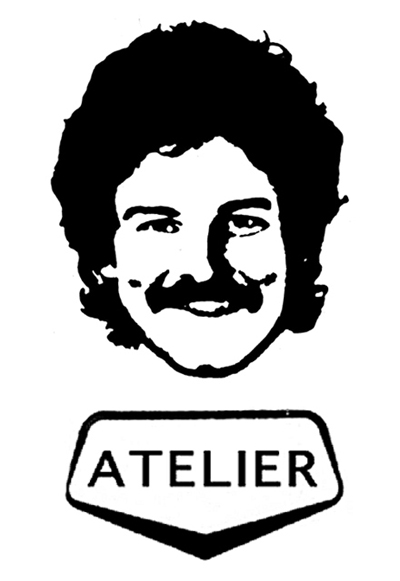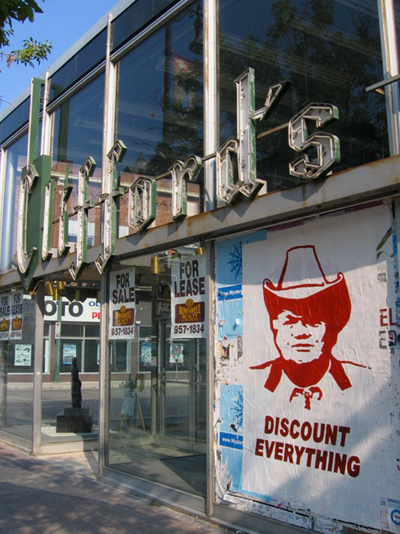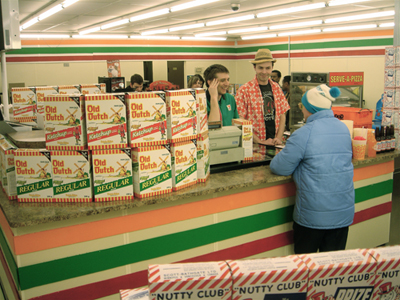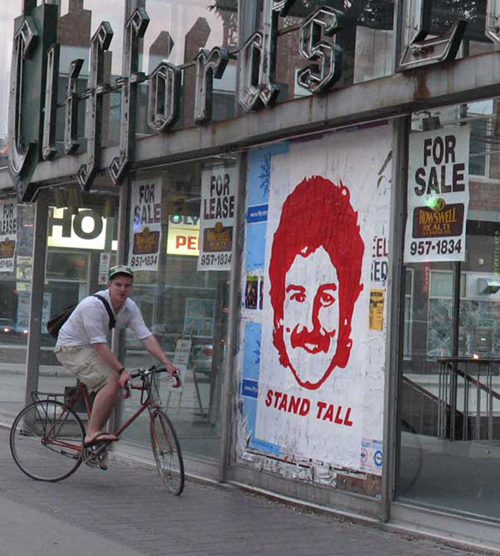Winnipeg Eats Itself:
L'Atelier national du Manitoba's
Scheme for Sovereignty
By Solomon Nagler
“Winnipeg is not a city. It is a form of irony.” [1]

Logo for L’Atelier national du Manitoba
There has been much speculation as to why such a unique filmmaking community has emerged from the Winnipeg Film Group, an infamous filmmaking cooperative founded over 30 years ago in the world’s coldest city. [2] Drowned by sky and isolated by an ocean of wheat fields, filmmakers from this island city developed an edgy, original sense of Cinema that can be recognized the world over as distinctly Winnipeg. Common approaches and concerns for storytelling and image-taking emerge and subsequently reinvent themselves in the shadows of legendary Film Group alumni such as Guy Maddin and John Paizs. Recently, l’Atelier national du Manitoba has emerged as Winnipeg’s Nouvelle Vague. Breaching the radically individualistic and competitive habits of previous generations, l’Atelier creates work collectively. Composed of cineastes, archivists and visual artists, its agenda is overtly political and expands outside the cinema through various forms of subversive street art projects. Inside the theatre, its work incorporates established themes of prairie postmodernism, such as an obsession for ruined or damaged moving images (both celluloid and video based), ironic historicism, self-hatred, and narcissism. Pitting Winnipeg against itself, the collective creates nationalistic, sociopolitical, culture-jamming documents that explore the esoteric roots of Canada's other distinct society: Winnipeg, Manitoba.
WE call ourselves l’Atelier-National du Manitoba – to distinguish ourselves from the ‘Canadian filmmakers’ – this horde of rag-pickers which makes good business out of its old rags. […]
WE compose ciné-poems about our civic prison of misery. [3]
L’Atelier was concocted by Mathew Rankin, a former Winnipeg ex-pat who received most of his film training in Quebec and Iran, and Walter Forsberg, an American whose initial exposure to Winnipeg was as a programmer at the Chicago Underground Film Festival. L’Atelier’s fluctuating membership currently includes Rankin and Forsberg, as well as the local filmmakers Mike Maryniuk, Alek Rzeszowski, Eve Majzels, and Darryl Nepinak. Together they create projects under the banner of l’Atelier, as well as independent, self-authored works. Death by Popcorn: The Tragedy of the Winnipeg Jets (2006) was their inaugural collaboration. It is a media-collage tour de force, an overture that reveals its political purpose: uncovering the roots of Winnipeg’s distinct society by sifting through the ruins of its discarded visual history. Death by Popcorn is an allegorical study that reconsiders a tenuous time in Winnipeg’s history. The city had just lost its precious National Hockey League team, The Jets, and, consequently, was on the brink of a third mass uprising.

The Winnipeg artist Paul Butler in Death by Popcorn / Atelier national du Manitoba
Along with Les Québécois and Les Acadiens, Manitobans are another regional minority who have instigated several violent revolts against the Canadian federal government. The first was the failed Red River rebellion of 1869, when Louis Riel tried to establish a New Jerusalem in what is now known as St. Vital, a bustling suburb, housing Winnipeg’s largest and most successful shopping mall. [4] The second was the General strike of 1919, during which the city’s various labor groups joined forces to stage a violent protest against labor conditions imposed by the bourgeoisie working for Eastern Canadian companies. The most recent flaring of Winnipeg’s nationalistic temperament came in 1995 during the politically volatile month of May. 30,000 Winnipegers marched along the same paths as the Winnipeg General Strike demanding an end to the capitalistic ruin of Canada’s national sport and imploring NHL executives to “Save our Jets.”
Death by Popcorn does not attempt to clearly depict that moment in Winnipeg’s history. Instead, it is an experimental, historical mélange, aiming to explore Winnipeg’s peculiar national characteristics. These include a perpetual, narcissistic self-hatred, a subsequent obsession with finding a new Louis Riel-type messianic leader to alleviate this self-hatred, an incessant need to demand a bargain on everything from furniture to civic infrastructure, and the tendency of Winnipeg filmmakers to create work that incorporates textured, self-referential, expressionistic images.

"Winnipeg Without the Jets" from Death by Popcorn / Atelier national du Manitoba.
Designed by Paul Butler.
Death By Popcorn draws its source material from discarded Beta-format videotapes that were rescued from a dumpster by l’Atelier members. The city’s unforgiving natural elements took their toll on this fragile media; consequently, the images incorporated in the film are mere textured traces of their past Betamax glory. From this material, L’Atelier stitched together a compelling, fragmented history: an epic tale that descends into tragedy as Winnipeg’s hockey heroes become powerless against their foes. The film traces the rise and fall of this once-promising hockey team, and the sense of failure that later permeated the city as their team perpetually lost to its arch nemesis: Wayne Gretzky’s Edmonton Oilers.
As the sordid tale unfolds, Death by Popcorn’stextured fragments gain a manic momentum of turmoil and urgency. L’Atelier enlists the talents of civic luminaries such as Kern Hill Furniture Co-op magnate Nick Hill, whose howling television commercials became an anthem to Winnipeg bargain hunting rituals. Mustache bearing sportscasters wearing neon spandex biking shorts do their best to placate the maddening crowd, while pierogi tycoon Hunky Bill distracts the crowd with 30-second pierogi making lessons. Death by Popcorn’s use of seemingly insignificant local commercials is perhaps its most fascinating feature. In the philosophical spirit of Walter Benjamin, l’Atelier sifts through the ruins of community access and local television programs, weaving together fragments of outdated media in order to uncover an authentic portrait of the Winnipeg Nation. [5]

Burton Cummings in Death by Popcorn / Atelier national du Manitoba
The film also introduces what has since become an Atelier obsession and infamous trademark: the messianic depiction of Burton Cummings, former front man to ‘60s rock band, The Guess Who. The filmmakers expose Cummings as he casts himself as the Jets’ redeeming savior. Playing the role of Doubting Thomas, l’Atelier edit together video documentation of a promotional photo shoot with this pseudo Louis Riel; degraded Beta tapes show him struggling with his hockey gear and stumbling as he skates in the now demolished Winnipeg Arena, all the while sermonizing to a temperamental nation of isolated skeptics. Death by Popcorn concludes with the team’s inevitable sale to a larger, more significant urban center: Phoenix. The clincher in this tragic tale is that, after almost becoming a Jet in 1979, [6] and after the team had been torn from its adoring homeland, Gretzky, bankrolled by big-bucks Arizona businessmen, bought the Winnipeg franchise and later became the team’s head coach.

Evil Gretzky, from Death by Popcorn / Atelier national du Manitoba
Everybody has self-destructive impulses but Winnipeg’s are more developed than most. The people of Winnipeg are perpetually committing acts of genocide upon their own heritage, rubbing out all traces of their own history, and consigning their civilization to the forgotten mists of time. [7]
Winnipeg’s particular style of cinematic experimentation assimilates formal techniques developed by other Canadian experimental film practitioners, fusing them into a coherent narrative framework to create a unique, indigenous storytelling style. L’Atelier's investigation of Winnipeg’s sociopolitical history draws on and expands upon the cinematic tradition of prairie postmodernism. Coined by eastern Canada’s filmmaking elite, the term“prairie postmodern”describes a style of filmmaking that emerged in the early 1980s, initially through the early works of John Paisz. [8] Paisz’ short film series The Three Worlds of Nick (1981 -1984) and his feature film masterpiece Crime Wave (1985), established not only a postmodern aesthetic, but also one of self-consciousness and paranoia. Paisz’ work has been categorized as postmodern because of its overt sense of ironic historicism, which accentuates the structure of his films. In Springtime in Greenland (1981), Paisz directs particular scenes as though he’s shooting a postwar propaganda newsreel, extolling the virtues of sterile suburban living. He enlists an overtly callous, dry narrator to evoke a sense of doubt within the dramatic elements of the film. Scenes are filmed in tableau-like perfection, mocking both the events within the film and the act of filmmaking itself. Paisz’ omnipresent sense of irony suggests that all his characters are explicitly conscious of the heavily constructed scenarios. In many of his early works, Paisz casts himself as protagonist, thereby introducing a style of diary filmmaking that emerged as a popular experimental documentary genre in eastern Canada. His films include an element of personal mythology, which subsequently became a crucial idiosyncrasy of Winnipeg filmmaking, particularly in the work of Guy Maddin and l’Atelier. [9] Paisz also pioneered a unique form of first person cinema, a term Winnipegers like to call “bargain basement filmmaking.” This method is considered by members of l’Atelier to be an enshrined Winnipeg ordinance. For example, Paisz shot most of his films himself, with a crew that seldom exceeded three, using a Bolex camera that had to be wound by hand.
The discount is to Winnipeg what soccer is to Brazil and police reports indicate time and again that Winnipeg’s notoriously prolific homicide rate is due mainly to bargain-related disputes [10]
L’Atelier’s obsession with partially ruined visual materials can also be seen as a mannerism inherited from previous generations of prairie auteurs. Degraded celluloid that looks discovered rather than created and beaten Beta tapes that have lost most of their magnetic resonance are yet another means of expressing the ironic historicism of the prairie postmodern. Guy Maddin was the first filmmaker to expand Winnipeg’s omnipresent sense of irony from the dramatic structure of Paisz to the actual material of celluloid itself. Maddin's expressionistic style is reminiscent of “primitive cinema,” where the boundaries between dramatic and experimental filmmaking are less defined. His work can be considered a rewriting of Canada’s inexistent early cinema history. [11] Films such as Tales From Gimli Hospital (1988), Archangel (1990), and Careful (1992) portray characters struggling with the fuzzy, high-contrast film material that has brought them to life. Words are spoken out of sync and gestures become unrecognizable, blurring into abstract forms of pure light. By creating a series of witty experimental narratives within an expressionistic style reminiscent of the 1920s, Maddin inspired evolution in Winnipeg’s self-reflexive cinema. Instead of utilizing a sterile, self-conscious mise-en-scène, Maddin introduced a cinema of ruins, where structural fabrications of the filmmaking process are made self-evident through deteriorated photographic material.
WE believe in the narrative perfection that lies within the abstracted limelight underneath the scratch films of Stan Brakhage, the single frame savagery of Bruce Conner, the absurdist stuttering of Martin Arnold, the obsessive Super-8 of Robert Morin and the meticulous geometries of Norman McLaren. WE wish to infect our dramatic plots with the formalist energies of these disfigured children of cinema. [12]
L’Atelier’s goal in its various film- and art-making projects is to expose the roots of Winnipeg’s ironic self-reflexive cinema. The film theorist and eastern Canadian filmmaker Bruce Elder has written a fascinating exploration of the self-reflexive tendencies of Canadian filmmaking in his book Image and Identity: Reflections on Canadian Film and Culture (1989). He claims that Canada’s unique experimentations in cinema emerge from a particularly ominous relationship between Canadians and their imposing geography. Examining both philosophical and cinematic trends, he claims that an overwhelming (and seemingly unknowable and mysterious) landscape induced a sense of fear and self-consciousness. This landscape also created a dualistic approach to filmmaking, “according to which reality is made up partly of mental stuff and partly of physical stuff, with the two entirely different from one another.” [13] According to Elder, this is what accounts for a certain type of postmodernism prevalent in Canadian cinema, whereby elements within the films themselves always become contextualized by the actual process of filmmaking. This stylistic movement resulted in unique formal experiments by filmmakers such as Michael Snow, Jack Chambers, and artists associated with Quebec’s Cinéma Direct movement. Elder’s assessment can also be used to account for the unique evolution of prairie postmodern cinema. Similar structural characteristics emerge within the films of Paisz and Maddin, particularly their emphasis on the structural limitations of the act of filmmaking, and its integration into the dramatic elements within the films.

“Spirited Energy” poster / Atelier national du Manitoba
The impact of Canada’s Great Plains on Winnipeg’s mindset is undeniable. It is a city drowned by its landscape, stranded by unbearable winters, and plagued by mosquitoes in the summer. To combat the civic doubt induced by such an inhospitable climate, various municipally funded promotional campaigns have been developed, aiming to instill widespread “Winnipeg Pride.” These campaigns, which always inevitably fail, have become another target of l’Atelier’s culture jamming projects. They mimic the city’s public poster campaigns with their own unsolicited banners and murals. Posters with the words“Stand Tall”scrolled underneath a high contrast print of Burton Cummings’ smiling, mustached face and iconic portraits of the late Nick Hill exclaiming “Discount Everything”foster an alternative, authentic sense of civic pride. For l’Atelier, the only authentic image is a ruined image and, as such, they believe that publicly funded initiatives, such as the “Love Me Love My Winnipeg”jingle contest and the “Winnipeg: 100 Reasons to Love It”campaign, which were both created in the late ‘80s to alleviate Winnipeg's endemic self-hatred, are nonsensical and futile. Rather, Winnipeg’s self-hatred must be unearthed and embraced through an alternative aesthetic exploration that includes sifting through the disastrous consequences of Winnipeg's destructive tendencies. L’Atelier’s political agenda is to stand by while the remnants from these perfect failures are tossed into Winnipeg's national dumpster. Allowing the harsh reality of the world’s coldest city to take its toll on the material, they then sift through the garbage looking for a perfect fragment that will become ideal fodder for their textured collages.

“Discount Everything” poster / Atelier national du Manitoba
WE believe that every frame of film and every whisper of sound must be dehumanized beyond belief through the use of hand processing, Super-8 to 16mm blow-ups, Xerox photocopiers, desynchronized shutter speeds and optical printing. The use of video is encouraged, provided that it is recorded on low-fi VHS cassette cameras characteristic of the early 1980s and then transferred and re-transferred ad infinitum from one VHS tape to another and back again. Digital technology (that scourge of Dogme!) is hateful, but Betamax may win amnesty on the condition that it too is subject to generational decomposition. Only in this way can cinema achieve the depth of self-loathing and self-destruction worthy of its new homeland in Winnipeg. [14]
Emphasizing their conviction that “history is written by the losers,”l’Atelier’s new projects aim to expand its agenda of exploring Winnipeg’s distinct national characteristics in fragments. I Dream of Driftwood (2007) is part of a series of l’Atelier Super 8 cityscape commissions. These films investigate Winnipeg’s urban landscape through degraded, textured, celluloid images. Winnipeg’s architectural configuration provides the most palpable morsels of its unique peculiarities. An established metropolis at the turn of the 20th Century, Winnipeg was once known as the gateway to the west, with architecture rivaling Chicago’s. As Canada expanded and depended less on railway transportation, Winnipeg’s booming metropolis went bust. Now enormous art deco warehouses and antique skyscrapers stand vacant and ignored. Subsequent urban renewal projects that never really took hold resemble awkward scars on an abandoned cityscape.
A poignant example is the Esplanade Riel bridge debacle. Etienne Gaboury, a Manitoba born descendant of Louis Riel, created a beautiful pedestrian bridge to connect Winnipeg’s French and English districts. Penny-pinching Winnipegers were initially convinced that the 22 million dollar bridge would be worth the money, for this architectural marvel would, without a doubt, restore the big city panache taken from them when they lost their hockey team. However, when it was discovered that a 1 million dollar toilet was being installed for a high-end restaurant on the bridge, Winnipeg nearly erupted into a full-blown riot. To appease this outrage, the city called on its modern-day Riel, Burton Cummings, to establish an authentic piece of civic culture on the bridge. Instead of the promised high-end restaurant, the vox populi succeeded in replacing it with a homegrown, fast food establishment partially owned by Cummings: The Salisbury House. The subsequent red carpet ceremony, and Cummings’ place in Winnipeg’s sense of self is the subject of l’Atelier’s current work in progress, Negativipeg.


Stills from Negativipeg / Atelier national du Manitoba
This new project is equal parts docudrama, public art program, and cable access talk show. The film centers on Winnipeg’s irreverent behavior towards Cummings, its civic pride savior. The project takes its name from a particular incident where Cummings tried to assert his messianic authority during a domestic altercation at a 7-11 convenience store. While trying to break up the dispute, using his status as a local demigod to mediate the situation, he was hit on the head with a beer bottle by a drunk Winnipeger. While Cummings was healing from the incident, a reporter asked him his opinion of the city he had personally chosen to liberate from its misery. Cummings response: ”Winnerpeg? Try Negativipeg!” Subsequently, Negativipeg investigates various local attitudes towards Cummings and The Salisbury House, asking those people interviewed to dramatically reenact the fateful incident at the 7-11. L’Atelier treats this incident as a pivotal moment in the assertion of Winnipeg’s national identity, the golden calf to Moses’ descent (with Slurpees in hand). They depict the confrontation as a smashing of the idols, kicking the medicine man out of town, or eating a burger to spite the mad cow. L’Atelier supplements the film component of Negativipeg through a barrage of illegal street art projects, plastering the Winnipeg cityscape with their “Stand Tall”banners. This caption is not only a reference to the famous ballad written by Winnipeg's prodigal son; it also signifies Winnipeg's need for salvation from its civic misery, a need to convince itself that all its suffering is warranted, and that soon another Riel figure will emerge to realize its dreams of sovereignty.

“Stand Tall” poster / Atelier national du Manitoba
Notre lutte est une lutte de liberté et d'indépendence. Notre pays, la vraie patrie de notre Manitoba, c’est le Québec, pas le Canada. Nous avons confiance, qu’un jour, il y aura un rendez-vous avec l'histoire et le Québec, et nous avons confiance aussi que le Manitoba sera là avec lui, ensemble, pour y assister. [15]
(Our fight is a fight of freedom and independence. Our country, the true fatherland of our Manitoba, is Quebec, not Canada. We have faith that one day there will be an appointment with history which Quebec will hold, and we have faith that Manitoba will be there with Quebec to assist.)
1. L’Atelier national du Manitoba, “The Seven Pillars of Atelier Aide-Mémoire on the Cinematic Form of the Winnipeg Jets,” notations by Matthew Rankin, BlackFlash 23, no. 3 (2006): 26. This is an excerpt from an annotated list of seven rules the Atelier posted on their editing room wall while completing Death by Popcorn: The Tragedy of the Winnipeg Jets (2006).
2. According to Environment Canada, the federal department in charge of weather statistics and analysis, Winnipeg is the world’s coldest city with a population over 600,000. See http://www.on.ec.gc.ca/weather/winners/highlights-e.html
3. This is an excerpt from “The Horizontalist Manifesto / Les Horizontalistes: Manifeste,” written by l’Atelier national du Manitoba in January 2005. The manifesto is published for the first time elsewhere in this volume.
4. Louis Riel’s religious convictions are particularly well documented in his collected journals. See Louis Riel, The Diaries of Louis Riel, edited by Thomas Flanagan (Edmonton: Hurtig Press, 1976), 169.
5. Walter Benjamin, “Theses on the Philosophy of History,” in Illuminations, edited by Hannah Arendt (New York; Schocken Books, 1985), 258.
6. One of the major dramatic threads of Death by Popcorn is a fateful game of backgammon the Jets’ owner Barry Shenkarow nearly played for Gretzky’s contract as he entered the NHL. However, Shenkarow passed on the game and Gretzky became property of the Edmonton Oilers instead.
7. L’Atelier national du Manitoba, “The Seven Pillars of Atelier Aide-Mémoire,” 26.
8. The term “prairie postmodern” gained in popularity with the broadcast of a television profile of the Winnipeg Film Group. The profile, created by the CBC National News, first appeared on The Journal on July 4, 1991.
9. This is particularly evident in Guy Maddin’s first film, The Dead Father (1985), and in his recent return to more autobiographical work, such as Cowards Bend the Knee (2003). L’Atelier’s obsession with uncovering Winnipeg lore can also be seen as an extension of the local obsession with personal mythology.
10. L’Atelier national du Manitoba, “The Seven Pillars of Atelier Aide-Memoire,” 25.
11. This idea was explored in the documentary Guy Maddin: Waiting for Twilight (Noam Gonick, 1997).
12. L’Atelier national du Manitoba, “The Horizontalist Manifesto.”
13. Bruce Elder, Image and Identity: Reflections on Canadian Film and Culture (Waterloo, ON: Wilfrid Laurier University Press, 1989), 29.
14. L’Atelier national du Manitoba, “The Horizontalist Manifesto.”
15. Ibid. My translation.
ABOUT THE AUTHOR
Solomon Nagler is a Canadian filmmaker originating from Winnipeg. His films and curated programs have played across Canada, in the U.S., Europe, and Asia. Retrospectives of his work have been featured in Paris (Festival des Cinémas Différents de Paris), Montreal (Ex-Centris), and Winnipeg (Cinematheque). Nagler is currently a full-time professor of Film Production at the Nova Scotia College of Art and Design in Halifax.
INCITE Journal of Experimental Media
Manifest
